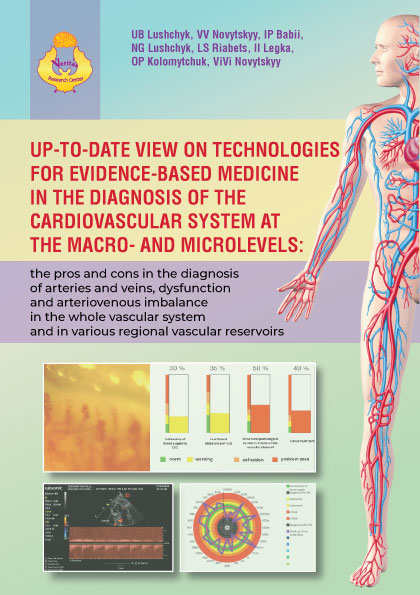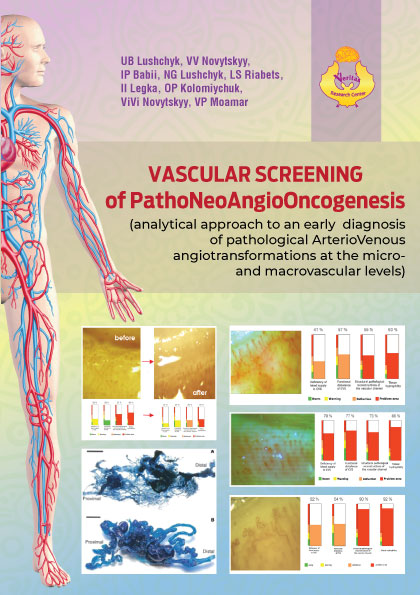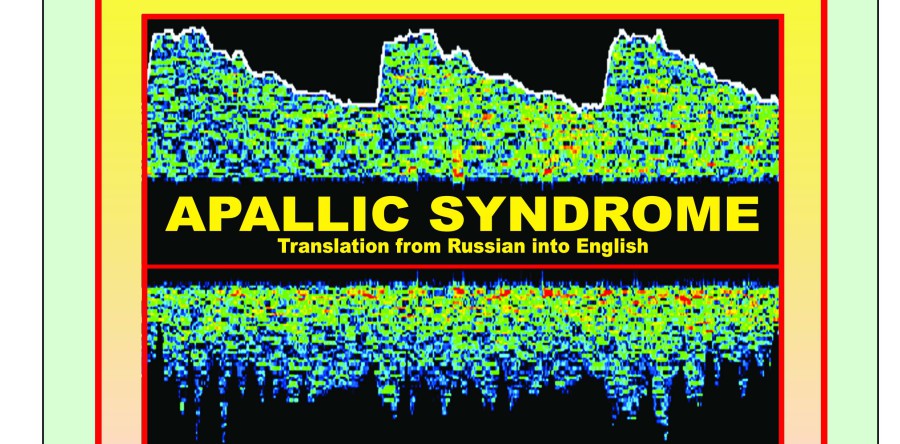Qualitative Assessment of Cerebral Dyshemia
ATLAS OF THE CLINICAL INTERPRETATION OF DOPPLEROGRAMS OF THE CEREBRAL ARTERIES AND VEINS BY THE AUTHOR’S METHOD OF ULYANA B. LUSHCHYK, M.D., Ph.D.
Lushchyk U. B.
The educational manual developed according to the educational program of the scientific center “Istyna”, maintained by the Department of Health of Ukraine
The present manual is a book, atlas & teach-yourself book of the unique methods of the clinical interpretation of ultrasound dopplerograms for the qualitative assessment arterial-venous – liquor balance disturbances in the functioning of the vascular cerebral system.
The educational manual provides fundamentals for USD of the cerebral-vascular pathology owing to methods of the USD dopplerography.
We have considered a new methodical approach to clinical ultrasound diagnosis cerebrovascular diseases including anatomic-physiological peculiarities of blood supply for arterial and venous cerebral beds, fundamentals for the topography of vascularization of the brain. The present manual presents main approaches to realizing of the physics of ultrasound phenomena and principles of the up-to-date ultrasound system’s functioning and also describes the clinical and dopplerographic picture that shows functioning of the collateral circulation tract, steal – syndromes. The illustrative material is proposed for more convenient assimilation of the theoretical knowledge and practical skills of the methods adoption.
The present manual is complied for medical students, post-graduate students, family physicians, neurosurgeons, psychiatrists, angiologists, angiosurgeons, and doctors of the functional and radial diagnosis, doctors of the intensive therapy departments.
Contents
1 Ultrasound diagnosis of vessels (USDV). Historical overview
1.1 About the history of beginning and development of USDV
1.2 History of creation of the clinical interpretation of data from the ultrasound dopplerography
2 Information received from the ultrasound dopplerography compared with other methods of diagnosing with the objectivating of neurovascular pathology
3. The applied anatomy and physiology of main cerebral arteries and veins
3.1. Everything starts from the anatomy
3.1.1.Anatomy of brachiocephalic arteries
3.1.2. The anatomy of cerebral arteries
3.1.3. Topography of areas of the brain vascularization by cerebral arteries
3.1.4. Anatomy of brachiocephalic veins
3.2. Let us remind and deeper study physiology of the cerebral circulation
3.2.1. Physiology of the cerebral arterial blood flow
3.2.2. Physiology of the cerebral venous hemodynamics
3.2.3. Arterial venous interaction
4. Physical fundamentals for the ultrasound diagnosis
5. Ultrasound diagnosis of brachiocephalic and cerebral vessels
5.1. Methods of investigation in arterial and venous cerebral links
5.2. Fundamentals of the ultrasound dopplerography (USDG) method
5.2.1. Method of investigation of brachiocephalic arteries
5.2.2. Method of the ultrasound dopplerography in brachiocephalic veins
5.2.3. Method of the transcranial dopplerography: examination of arterial and venous links
5.2.4. Method of the cerebral venous system’s examination
5.2.5. Algorithms of the USDG – examination of the cerebral arteries and veins
5.3. Transcranial scanning
5.4. Use of the USDV method
6. Quantitative and qualitative assessment of dopplerograms
6.1. Main quantitative characteristics of dopplerograms
6.2. Criteria for the qualitative analysis of dopplerograms of brachiocephalic and cerebral arteries
6.2.1. Visual analysis of dopplerograms in the normal state
6.2.2. Peculiarities of spectrograms under the pathology of brachiocephalic arteries
6.2.3. Tandem – stenosis of carotid arteries
6.2.4. Examples of the spectrograms’ interpretation under the pathology of the arterial link
7 Criteria of the clinical interpretation of cerebral dopplerograms
7.1. Condition of the arterial blood flow
7.2. Disorder of the venous outflow
7.3. Criteria of the clinical interpretation of the condition of the pumping function of the myocardium
7.4. Criteria of assessment of the arterial venous liquor balance
8. Intracranial hydrodynamic disturbances
8.1. USDG and intracranial hypertension (ICH)
8.2. Intracellular hypertension
8.3. USDG – patterns under arterial venous malformation (AVM) and arterial venous shunting (AVS)
9. Analysis of functions of the collateral tracts of the arterial and venous cerebral blood supply
9.1. Functional ability of the communicating arteries
9.1.1. Examination of functions of the anterior communicating artery
9.1.2. Examination of functions of the posterior communicating artery
9.2. The supratrochlear anastomosis
9.3. Steal – syndromes of the cerebral circulation
9.3.1. Functional tests for revealing of the vertebral – subclavian steal – syndromes
9.4. Reserve potential of formation of tracts of the collateral circulation with stenosing injuries of the main arteries of the head (MAH)
9.5. Examination of the venous collateral circulation
10. Functional tests for checking of the vascular reactivity
11. Applied capacities of the ultrasound clinical diagnostics of the vascular pathology in the psychoneurological practice
11.1. Age peculiarities of functioning of the arterial and venous cerebral beds of children and adults in the normal state
11.2. Hemodynamic substantiation of the clinical picture of some infant’s neurological diseases and syndromes with the help of the ultrasound diagnosis of a vascular canal in the brain
11.3. Unique potential of the ultrasound diagnostics in the cerebral venous bed in the differential diagnostics of the genesis and prognosis of a course of acute cerebral circulation impairments (ACCI)
11.3.1. USDG-patterns under ACCI of the ischemic type
11.3.2. USDG- patterns under ACCI on the background of the brain tumor
11.3.3. USDG-patterns under ACCI of the hemorrhage type
Conclusion
Courses of the clinical ultrasound diagnostics of the arterial and venous beds’ pathology in a fetus, an infant, children and adults
More information about the price and how to buy




